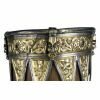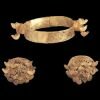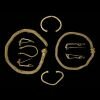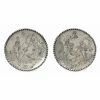
This massive gold ring was found by Mr R. Treadgold in 1998 near Raglan in Monmouthshire, Wales. It seems much larger than most finger-rings and you might think that the person who owned it had very thick fingers. It was probably not worn directly on a finger, however, but would have fitted over a leather glove.
The ring is a signet ring, with which one could make an impression in wax. It would have been used in this way to close letters and keep their contents private, or to authenticate documents. The design shows a lion passant (a heraldic term meaning 'walking to the left') on a bed of flowers. Around the lion is an inscription in English that reads 'to yow feythfoull' or 'feythfoull to you' - in today's English 'faithful to you'. The letters 'W' and 'A' on either side of the lion are probably initials for names such as William and Anne.
The ring was probably made between about 1440 and 1475, the time of the Wars of the Roses, a series of civil wars fought in England from 1455 to 1487 between the followers of the Houses of Lancaster and York. So far it has not been possible to confirm the identity of the wealthy owner, or how the ring ended up in a field near Raglan. The findspot near Raglan Castle and the initials make William Herbert, first Earl of Pembroke (executed after the Battle of Banbury in 1469), a tempting candidate. He married Anne Devereux. The motto is a private one symbolizing fidelity between husband and wife.








